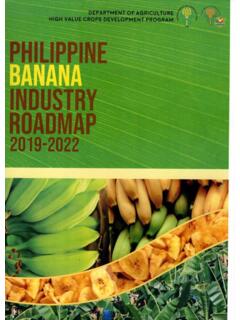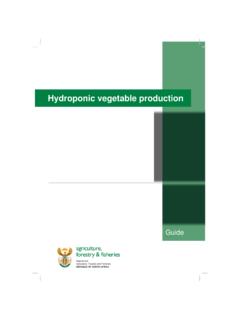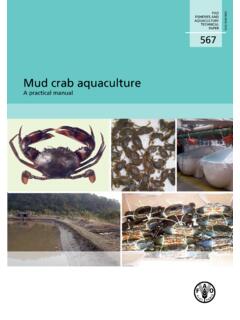Transcription of Department of Agriculture
1 FINAL REPORT Inter Provincial Dependency for Agricultural Development Submitted to Ministry of Agriculture , Land Management and Cooperative Department of Agriculture Harihar Bhawan, Lalitpur, Nepal Submitted by Development Vision Nepal P. Ltd. (DVN), Dhumbarahi-4, Kathmandu July, 2018 TABLE OF CONTENTS EXECUTIVE SUMMARY I CHAPTER I: BACKGROUND 1 INTRODUCTION 1 OBJECTIVE OF THE ASSIGNMENT 2 SCOPE OF THE ASSIGNMENT 2 CHAPTER II: APPROACH AND METHODOLOGY 4 INCEPTION REPORT PREPARATION AND APPROVAL 4 COLLECTION AND REVIEW OF SECONDARY INFORMATION 4 SOURCE OF DATA 4 DESK REVIEW 4 FIELD WORK 4 DESIGN OF DATA COLLECTION INSTRUMENTS 5 DATA ANALYSIS AND REPORTING: 5 REPORT PREPARATION 5 CHAPTER III: STUDY FINDINGS 7 DESK REVIEW 7 CONSTITUTIONAL PROVISION FOR Agriculture SECTOR 7 Agriculture DEVELOPMENT IN NEPAL 14 FIELD RESEARCH FINDINGS 31 POLICY, PROGRAMS AND FUTURE DIRECTION OF THE PROVINCES 32 KEY COMMODITIES AND PROVINCIAL INTERDEPENDENCY 41 PROVINCIAL INTERDEPENDENCY FOR INPUT SUPPLY 48 KEY SERVICE DELIVERY INSTITUTION AND THEIR ROLES 48 CHAPTER IV.
2 CONCLUSION AND RECOMMENDATIONS 51 CONCLUSION 51 RECOMMENDATIONS 56 REFERENCES 58 ANNEXES 59 Acknowledgements Department of Agriculture (DoA), entrusted Development Vision Nepal P. Ltd. (DVN) in carrying out the study entitled "Inter Provincial Dependency for Agricultural Development ". The study concentrated on all seven provinces of the country with special focus on provincial Agriculture ministries and agencies related to agricultural development. The company is indebted to DoA for providing such an important task and is very much obliged to Director General and concerned officials of the Department for providing guidance, support and valuable suggestions throughout the study period. Thanks also go to all senior officials of MoALMC, DoA and Agricultural Directorates for active participation on review of draft report presentation and giving their valuable suggestions for enriching the report. The company would like to extend its sincere gratitude to all individuals and organizations in all provinces for providing first-hand information and data during the field study.
3 Last but not the least, we are grateful to officials/respondents and key informants who provided their valuable time to us sharing their experience and providing information. Development Vision Nepal P. Ltd. July, 2018 i | Executive Summary Executive Summary 1. Background Agriculture is still the largest economic sector that solely contributes more than 30% of National GDP. The restructuring of the state provided opportunities to improve Agriculture governance as well. Nepalese Agriculture is characterized by higher level of diversification in terms of climatic and geographic variations. Due to the high range of altitudes and temperature throughout the country, Agriculture in Nepal has peculiar characteristics. Within almost 200 Km in north-south, we find all kinds of temperature and crop types as well. This provides both opportunities and challenges for Agriculture development in Nepal. After introduction of the new constitution, the unitary country has been restructured into 7 provinces.
4 These provinces have been divided mostly on the geographic basis. With perspective of Agriculture development, all provinces have particular strengths and some weaknesses. Provinces 1, 3, 5 and 7 have both temperate and tropical climates and more diverse in terms of Agriculture crop production potentialities. While province 2 has mostly tropical climate, province 4 and 6 have largely temperate climate and are less diverse. These provinces will be interdependent to each other in terms of economic production. Further, some provinces will be surplus in certain commodities and deficit in other commodities. Not only production, there will be an interdependency for inputs and product markets. Against this backdrop, this study was designed to support Department of Agriculture in identifying provincial strengths and weaknesses to further plan its future development strategies. The study will also support in identifying proper institution for carrying out such Agriculture activities at province level.
5 2. Methodology and Approaches A combination of desk review and field studies were adopted to accomplish the task. The study team in consultation with the client finalized the methodology, tools and time schedule as well as the outputs delivery plan. The study team collected and reviewed the relevant data/information on sectoral institutional arrangement that is being worked out and finalized. The team met with relevant officials and gathered information on the ongoing work being done on the structural reform. The study team also visited the website of major actors of the state reforms including the Office of the Prime Minister and Council of Ministries (OPMCM), Ministry of Federal Affairs and General Administration (MoFAGD), Ministry of Agriculture , Land Management and Cooperatives (MoALMC), Ministry of Finance (MoF), National Planning Commission (NPC), Department of Agriculture (DoA), Department of Livestock Services (DoLS) and other related institutions like Trade & Export Promotion Center (TEPC) and FNCCI for gathering materials to support the study.
6 3. Study findings - Desk Review Constitutional provision for Agriculture sector Constitutionally Agriculture is more state matters although it has also been the concurrent function of all central, state and local government. The authority of Agriculture extension lies with local and state while regulatory and policy are the central matters. The constitutional provisions for Agriculture sector are as presented in the table below. ii | Executive Summary The government expedited the restructuring process immediately after endorsement of constitution. Ministry of General Affairs accomplished the functional analysis of major 5 sectors. The functional analysis was made on the basis of 5 principles; subsidiarity principle, economies of scale, social inclusion and national priority, equity and economic stability and unbundling for achieving clear assignment. Based on the constitutional provisions, international practices and ongoing activities, the experts team recommended Agriculture functions in three tiers of government.
7 Agriculture sector performance in recent years Agriculture is the oldest industry since civilization. More prominently the first periodic plan 1956-1961, identified Agriculture as one of the promising sectors for poverty reduction. Since the formulation of fifth five year plan (1975-1980) to tenth five year plan (2000-2005), the priority for poverty reduction was given to Agriculture through increasing productivity of the existing crops and diversified production of horticultural crops. However, the growth of Agriculture sector remained short of population growth requiring rapid transformation of subsistence farming to more commercialized and diversified. Agriculture Perspective Plan (1995-2015), arguably the first comprehensive sectoral plan; identified Agriculture sector as engine of growth. It envisaged a multiplier growth effect of Agriculture sector to other sectors of economy and envisioned input-output model of Agriculture growth and identified fertilizer, technology, rural infrastructures and irrigation as major factor inputs for achieving broad based Agriculture growth.
8 APP forecasted the per capita AGDP growth to 4% from existing base of in 1995. With implementation of the APP the incidence of poverty was expected to come down from 42% in 1991/92 to 14% in 2014/15, whereas the latter figure without the APP would have been 29%. However the APP experienced a mixed results in terms of target output. The cereal crops target achievements were far below while some subsectors performed very well even exceeding the targets which included horticultural and high value crops, fisheries and forests. The diminishing contribution of Agriculture sector also reflects the lower productivity of sector as well. As GDP growth still relying on AGDP growth, the two digits of GDP growth can only be achieved with minimum 6% of AGDP growth which seems unlikely with current trends of relying production growth mainly on monsoon. This year s Agriculture growth is expected only at due to the shrinkage of main crops rice by Rice which contributes to to AGDP was heavily affected by unlikely climate and floods in Terai region.
9 The growth of Agriculture sector was limited only to during last decade. However other sectors are expected to grow by large percentage due to regular availability of energy and petroleum. Industry sector whose growth was stagnated to 3% during last decade is expected to grow by 8% this year, which is good indication despite lower growth of Agriculture . Prime Minister Agriculture Modernization Project (PMAMP) was launched in 2016, with the objective of specialized production. The four categories of programs were initiated based on the specific products area. Twenty-seven point of commitments of then Minister laid the foundation for development of PMAMP project. a. Crop Production Cereal crops - Nepalese Agriculture is dominated by cereal crops. Rice, maize and wheat constitute more than 80% of cereal area and production. Rice solely contributes to of AGDP and is the major cereal crop. The production of rice largely depends on monsoon and timely availability of fertilizer and improved seeds.
10 As most of the Agriculture research is based on rice, yet the productivity of this crop is below mt/ha. Pulses - The production of pulse crops has been at constant rate during last five years without significant growth. However, the total production of pulse crop is expected to grow by during current fiscal year 2017/18. The production is expected to reach 369,000 metric tons in the current year which is far below than the annual demand. Lentil constitutes more than 50% of total pulse crop iii | Executive Summary production and it is also the sole export item of the country. The low productivity of pulse crop is major issue for Agriculture research. Cash crops - The productivity of oilseed is similar to pulse crops. However, the remarkable increments in the production of oilseed have been achieved in current fiscal year with the growth accounted compared to last season. Potato, one of major cash crops has performed well during recent years.






